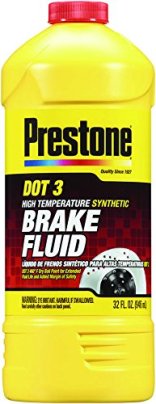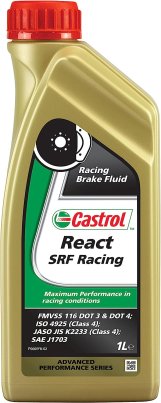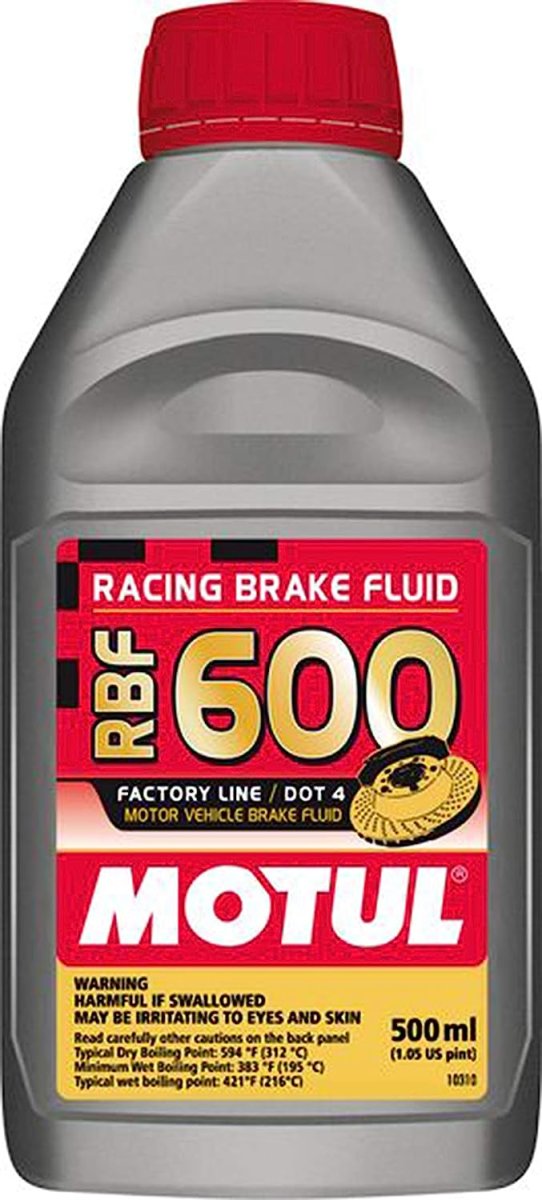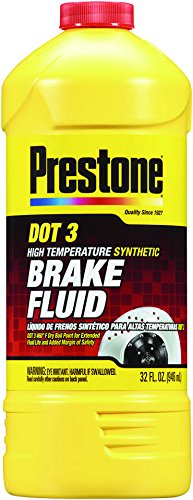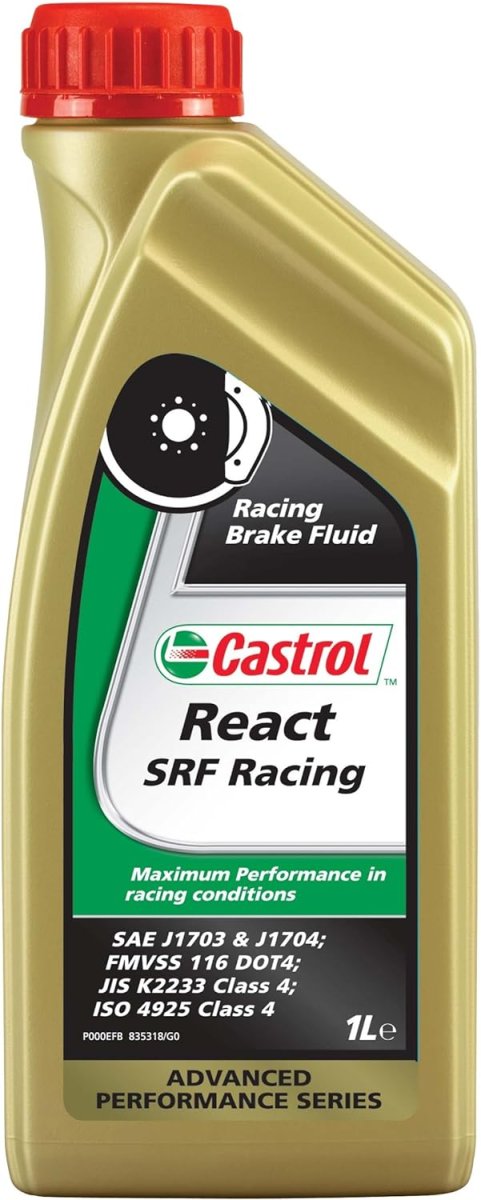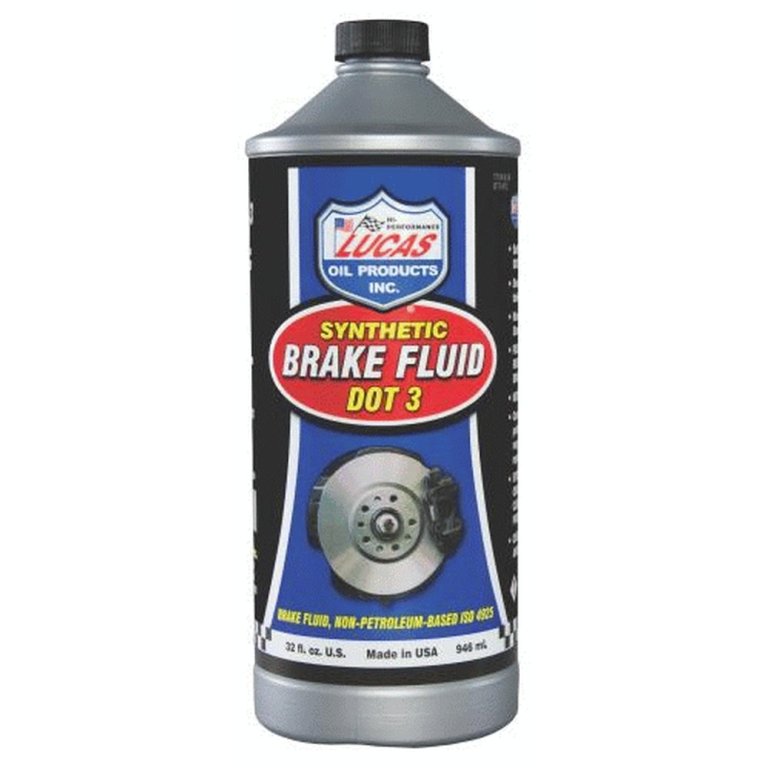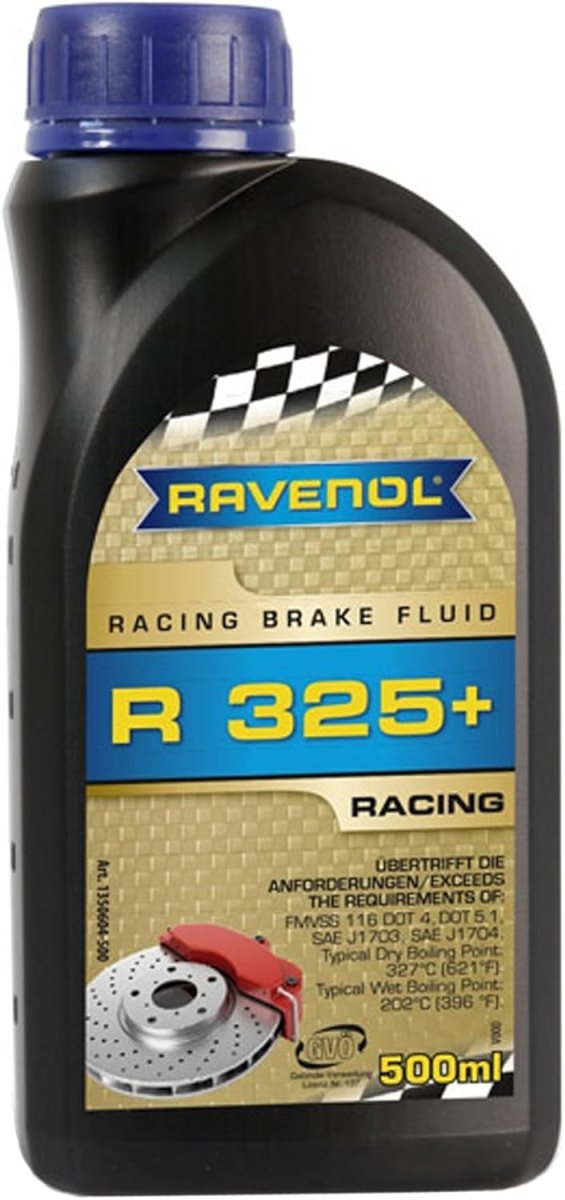We may earn revenue from the products available on this page and participate in affiliate programs. Learn more ›
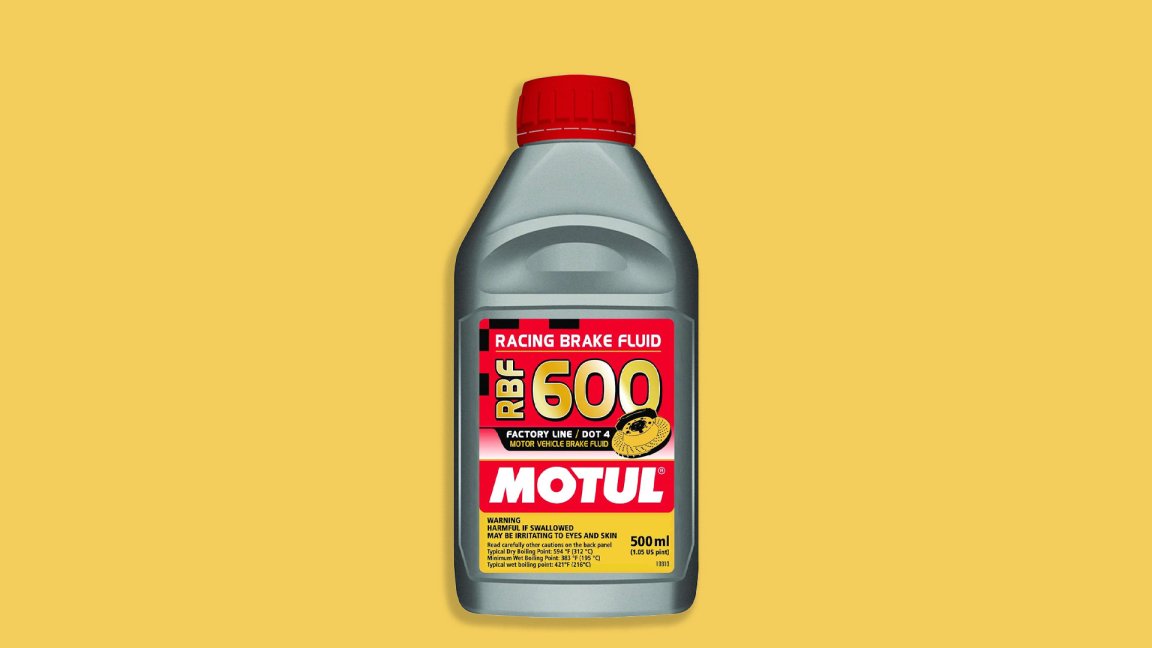
Brake fluid is one of your car’s many consumable components. Most brake fluids are hygroscopic, meaning they absorb water. The more water it absorbs, the lower the boiling point, which decreases performance. Higher-quality brake fluids have a greater resistance to breaking down due to heat. But, brake fluids aren’t universal. So the best option out there, still may not be the right version for your car.
There are many different types, and some are meant for applications that you might not necessarily need. But first and foremost, it’s crucial that you use a quality fluid that meets or exceeds your vehicle manufacturer’s standards. The easiest way to determine what’s correct for your car is to look in either the owner’s manual, or quite often, it will be on the brake fluid reservoir cap. Once you determine what you need, the info below will help guide you towards the best options—use this list and save some time and money!
Summary List of Best Brake Fluids
- Best Overall: Motul RBF 600 DOT 4 Synthetic Racing Brake Fluid
- Best Value: Prestone DOT 3 Synthetic Brake Fluid
- Best High-End: Castrol SRF Racing Brake Fluid
- Honorable Mention: Lucas Oil Brake Fluid
- Honorable Mention: RAVENOL R 325+ Brake Fluid
Our Methodology
We didn’t get our hands on each and every one of these fluids and run them in our own personal automobiles. But our combined knowledge of the industry, as well as strong familiarity with some of the options, led us to coming up with this list. We’re proud of its versatility and availability at all price points. For more on how we select products, check this out.
Best Brake Fluids: Reviews & Recommendations
Best Overall: Motul RBF 600 DOT 4 Synthetic Racing Brake Fluid
Pros
- Inexpensive for its performance
- Exceeds normal DOT 3 specifications
- Applicable for high-performance driving
Cons
- Short shelf life
Motul’s popular RBF 600 DOT 4 fluid is great for any application, but especially for high-performance driving such as rally, autocross, track days, and even racing. It comes in convenient 500 mL bottles for easy bleeding, and the price is a great value for such a high-performance, quality synthetic fluid.
There isn’t much to discuss negatives-wise, but it does have a shorter shelf life than other fluids, especially after being opened and having its airtight seal removed.
Best Value: Prestone DOT 3 Synthetic Brake Fluid
Pros
- Bottle size is often good for a complete and thorough flush
- Meets or exceeds most OE standards
- Very low price
Cons
- Not as long-lasting as DOT 4 and 5 competitors on this last
- Not good for performance driving, but then, it’s just fine for day-to-day street duty
This fluid is a mix of polyglycol ethers, which ensures the brake-system operation will not cause dangerous vapors. It’s ideal for disc and drum brakes as well as ABS systems. It is wet and dry boiling points exceed the minimum government standards, and it provides an extra margin of safety during extreme braking conditions.
This DOT 3 fluid is one of the most common brake fluids for passenger cars and is a brand name that’s very reasonably priced. It does more than enough for daily drivers and commuters who require typical braking power without performance-oriented results. One 32-ounce bottle is often enough to completely flush a single vehicle’s braking system.
The biggest complaint about this product is, while ordering online, it may not have a lid, and the seal may break during shipping. This is problematic because brake fluid absorbs water at a faster rate if the seal is broken. It can also be contaminated if it’s not sealed properly.
Best High-End: Castrol SRF Racing Brake Fluid
Pros
- Excellent life
- Stands up to prolonged heat quite well
- Comes in convenient large bottle
Cons
- High price
This brake fluid features a European formula with very high wet and dry temperature ratings. It exceeds DOT 3 and 4 specifications and provides superior braking performance in any high-performance environment. The product also has excellent anti-vapor lock features.
Castrol SRF reigns supreme when it comes to high-end brake fluid for racing. It has a wet boiling point that is higher than most high-performance brake fluids’ dry boiling point. After using this fluid you can hammer down the brakes, yet you won’t lose braking capacity and your pedal won’t go to the floor. It consistently withstands the brake heat when you’re racing.
The biggest problem with this brake fluid is it’s expensive. Also, it’s geared towards track junkies, so it might be too much for daily driving duty.
Honorable Mention: Lucas Oil Brake Fluid
Pros
- A very sturdy street-centric fluid
- Very long life
- Maintains good braking system life
- Punches above its DOT 3 weight in performance
Cons
- Not as sturdy as high-quality DOT 4 and 5 fluids, but still solid for DOT 3
- A little more expensive than other DOT 3s
Lucas Oil’s blend of brake fluid is one of the best available and this high-quality mixture is impressive. The fluid is compatible with every rubber component of the braking system. Plus, it’s capable of being blended and mixed with other brake fluids as well. It works by protecting and strengthening your brakes so they last longer and are more reliable.
The premium brake fluid is rated as a DOT 3 and is a blend of polyethylene glycol ethers and additives. It can meet, and at times even exceed, the industry minimum dry boiling point of 401 degrees Fahrenheit. This fluid works in all braking systems that can take DOT 3. It protects your brakes against rust and corrosion, prevents hardening and softening of the rubber, and provides excellent lubricity.
There are a few things to keep in mind with this particular blend of brake fluid, however. The first is that it does contain high wet and boiling points. This is something you should keep track of, as the boiling point temperature may decrease over time. Plus, the packaging feels flimsy and weak and may break or pop open before getting to you.
Honorable Mention: RAVENOL R 325+ Brake Fluid
Pros
- Great for performance driving
- Great for towing
- Long-lasting strength
- Stores well
Cons
- Expensive
RAVENOL’s brake fluid is made in Germany and is geared towards everyday and performance-based driving. It exceeds SAE and federal regulations, and is designed for extreme and frequent braking and to minimize moisture absorption.
It’s a great product if you take your car to the track. It also should help with brake fade under high stress, such as while towing. It’s a really good-quality brake fluid, and the can is air tight and can last a few years after you open it. There is plenty in the can to flush out a number of brake systems. Overall, your braking and brake pedal should feel significantly better after flushing with RAVENOL.
Our Verdict on the Best Brake Fluid
Our pick for the best brake fluid is the Motul DOT-4 100 Percent Synthetic Racing Brake Fluid. While it’s slightly pricier than other brands, it improves pedal feel, protects against water penetration, and increases performance for both daily drivers and racers.
A less expensive option is the Prestone DOT 3 Synthetic Brake Fluid.
Important Things to Know About Brake Fluid
It’s important to point out the differences between different brake fluid DOT ratings.
DOT 3: This poly glycol-based brake fluid is intended for vehicles that are exposed to normal driving conditions. It has a wet boiling point of 140 degrees Celsius and dry boiling point of 205 degrees Celsius. Over the course of a year, it absorbs moisture at a rate of about 2 percent of its volume. It can be safely mixed with DOT 4 and DOT 5.1 brake fluids. The best DOT 3 brake fluid is very strong and can damage your vehicle’s paint in the event of a spill.
DOT 4: This fluid is also poly glycol-based and is intended for vehicles that are used in higher altitudes. It has a wet boiling point of 155 degrees Celsius and a dry boiling point of 230 degrees Celsius. Similar to DOT 3 brake fluid, the best DOT 4 brake fluid absorbs moisture at a rate of about 2 percent of its volume per year, but it has somewhat higher wet and dry boiling points. It can also harm your vehicle’s paint.
DOT 5: This synthetic blend brake fluid has a silicone base. It does not absorb moisture and, as a result, can cause corrosion in your brake line if not properly monitored. It’s wet boiling point is 180 degrees Celsius and dry boiling point is 260 degrees Celsius. DOT 5 brake fluid is intended for race cars and other performance-based vehicles.
DOT 5.1: This poly glycol-based brake fluid absorbs moisture at a rate of approximately 2 percent of its volume per year. It has a wet boiling point of 180 degrees Celsius and a dry boiling point of 260 degrees Celsius. Like DOT 5, it’s mostly intended for race cars.
FAQs on Brake Fluid
You’ve got questions. The Drive has answers.
A: Brake fluid works in conjunction with your vehicle’s hydraulic system. The master cylinder requires fluid to put pressure in the brake line, causing it to move. The fluid’s pressure activates the mechanical brakes (the disc, pads, and caliper), which put pressure on the wheel, causing it to stop. The vehicle will not stop properly without brake fluid.
A: Corrosion Resistance: Look for a product that repels corrosion in areas such as the ABS control valves, master cylinders, wheel cylinders, and calipers. Manufacturers use various additives in their products to fight corrosion. Some types of brake fluids are more corrosive than others. For example, silicone is less corrosive than glycol-ether-based fluids.
Viscosity: A vehicle’s brake fluid should maintain its viscosity during many operating temperatures. This will ensure that the stability control, traction control, and anti-lock braking system function properly. As a result, it’s important to prescribe to a viscosity recommended by the manufacturer. In general, DOT 5.1 brake fluids have the lowest viscosity over a wide range of temperatures.
Compatibility: Some brake fluids are designed for certain brake systems, such as disc brakes or drum brakes. Others are designed for various systems. Do not purchase a cheap brake fluid because it’s cost effective. It’s essential that it’s compatible with your specific vehicle in order to work properly and prevent brake failure.
A: There are glycol-based and silicone-based brake fluids. Silicone-based fluids are for vehicles without ABS. Check your owner’s manual to determine which type of fluid you need.
A: Over time, brake fluid loses its effectiveness because it absorbs moisture and water through areas such as the brake system’s seals. Too much moisture can reduce stopping power.
A: Check your owner’s manual. It will contain a schedule based on either time or miles driven to determine how often you need to change the fluid.
A: First, locate the brake fluid reservoir under the hood of your vehicle. Typically, it is well marked and in a plastic container on the driver’s side of the engine. Next, remove the top from the container and look at the marker on the side of it to determine the fluid’s level. Finally, make sure there are no contaminants or discoloration in the container.

